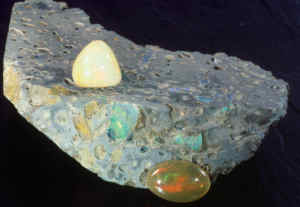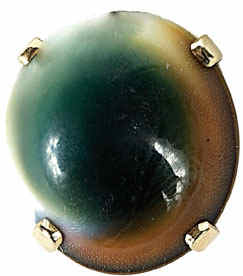Canada Rocks!
February 01, 07 by
Artisanal prospecting by amateur weekend hobbyists is widespread in all Canadian provinces. This has led to a dramatic increase in both the quality and volume of white opal being recovered manually from bedrock in the Okanagan Valley of southern British Columbia.
The new opal is not sufficient to sustain more than a local tourist trade at this time. Similarly, amethyst continues to be mined and sold locally by small-scale operations near Thunder Bay in Ontario.
On the exploration front, exciting new discoveries include gem-quality peridot and acceptable chrysoprase from the Yukon Territory. Either of these species may become players on the international stage in the future. On the commercial front, production and marketing of Canada’s two main stalwarts; nephrite from British Columbia and ammolite from Alberta, continue at roughly the same pace and scale as in 2004.
Advanced exploration activities by True North Gems, Inc., which is based in Vancouver, British Columbia, include the collection and processing of bulk samples designed to test historic discoveries of emerald, ruby, and sapphire for value and grade. True North collected approximately 2,500 metric tons of emerald ore at Regal Ridge, now re-named the Tsa da Glisza project. The company also collected nearly 110 metric tons of sapphire ore from the Beluga property on Baffin Island and exported 15 metric tons of ruby ore samples from the Fiskenaesset district in nearby Greenland. At all three of these deposits, systematic scientific exploration is yielding encouraging results when new technologies are tailored to specific challenges.
In this regard, True North has successfully used ultraviolet light for regional mapping of corundum alteration phases; employed radiometric age dating for target discrimination; demonstrated the application of basic geologic mapping for resource estimation; intercepted gemstone mineralization at projected depths in core drill holes; and has begun testing mechanized optic sorting as an economic alternative to the hand-sorting of gemstone rough.
Infrastructure in Canada is excellent to acceptable, even in the Arctic, and the country’s risk is negligible. The system of government involves a mature parliamentary democracy with a well-established code of law governing gemstone mining as well as all natural resource development activities. Government bureaucracy can be an impediment to rapid performance, but this operational obstacle is more than counterbalanced by ample resources for investment funding for gemstone ventures in both the public and private domains.
Half of all diamond exploration dollars spent in the world in 2005 was spent in one country: Canada. If True North is successful with any of its advanced exploration plays for the “big three,” one might fairly anticipate the same trend in expenditures for colored gemstone exploration in the years ahead.
Article reproduced courtesy of the International Colored Gemstone Association (ICA).


